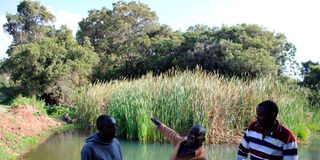‘Myths and legends help to keep our river, forest safe from destruction’

Ndaragua Water Engineer Joseph Mwangi, community leader David Muhoho and Joseph Wamucii at River Mutara Water catchment area in Nyandarua
What you need to know:
- He often told us a story about a farm worker who disappeared in a swamp within the river source.
- The swamp is now known as Meru Dam since the victim was from Meru.
“My name is David Muhoho, a 60-years-old farmer from Thigio Village in Ndaragua , Nyandarua County. Mutara River originates from our farm, running about 75 kilometres to Sosian River in Laikipia County.
As a village elder, I am encouraged that my community has embraced the conservation of River Mutara, efforts that we are all proud of. Protection and conservation of the river source is historical dating back to the 1950s when my father Peter Muhuhu worked as a farm manager employed by the then colonial District Commissioner Henry Sharp, who loved to conserve the environment.
In 1965, the farm, among others, was converted to a settlement scheme and my father inherited the catchment area. My father, with lessons from his colonial employer, embraced environmental conservation.
He often told us a story about a farm worker who disappeared in a swamp within the river source. The swamp is now known as Meru Dam since the victim was from Meru. It was explained that Peter Mugambi was swallowed by a large snake in the swamp. The snake had caused an earthquake as it stretched about an hour before Mugambi went swimming.
This narration makes the community afraid to mess with the forest and the river source. There are underground breathers from the river source that produce hot water in the morning, and the water is believed to be a constant reminder that destruction of the river catchment area might invite some disaster.
But I must confess that reduced water volumes from the river have caused conflicts between the farmers upstream and herders in Laikipia downstream in the last 10 years. The reduced water volumes are caused by our neighbours downstream who engaged in massive destruction of the riparian lands. I am concerned and pained by the destruction.
Apart from encouraging and enlightening the community on the importance of conserving the water source, before he died, my father also left a curse that no one should ever cut a tree within the river banks and its source.
These historical happenings and stories have scared illegal loggers, the community, or family members from cutting the century-old trees. They are left to waste at the catchment areas when they fall due to old age. No one even cuts a branch or gets firewood from that area — we consider the catchment area a forbidden land.
The other factor why the catchment area is conserved is civic education by environmentalists and area MCA Mwangi Kagwe, who is passionate about conservation. We are proud of the MCA for consistent annual tree-planting exercises at the catchment and along the river even before we elected him. His actions, commitment, and sacrifice are a motivation to the youth and the entire community in conservation efforts.
Through conservation efforts, the river has never dried from the source, making it possible to practise climate-smart agriculture to feed our families and livestock. I would encourage other communities within water catchment areas to plant environment-friendly trees, conserve what they have and avoid encroachment within riparian lands as we have done in our area. Farming activities keep our youth busy.
Compiled by Waikwa Maina




